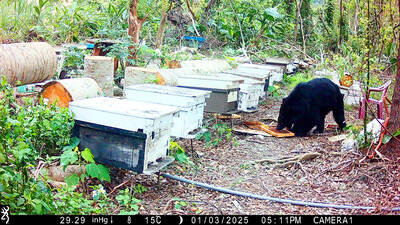The government should consider the impact of offshore wind farms on shipping, fisheries and marine life before allowing energy developers to build more installations, Taiwan People’s Party (TPP) lawmakers and experts said on Wednesday.
The government plans to phase out all nuclear power generation facilities and generate 20 percent of electricity from renewable energy sources by 2025, including 5.7 gigawatts (GW) from offshore wind power. From 2026 to 2035, it plans to source an additional 15GW from offshore wind farms.
Before the government releases new guidelines for phase 3 offshore wind farm development and waterway plans near target farms, it should first review the results of the previous two stages, as only 7.5 percent of the 2025 goal (5.7GW) has been achieved, TPP Legislator Tsai Pi-ru (蔡壁如) told an online news conference.
The phase 3 rules are expected to demarcate “red zones” that prohibit offshore wind farm construction, following controversies about the potential effects of wind farms on fisheries, shipping lanes and marine ecology.
Many controversial issues were discussed only after energy developers had received approvals from the Environmental Protection Administration, TPP caucus whip Chiu Chen-yuan (邱臣遠) said, likening it “to shooting an arrow first before drawing a target.”
The government should look into the needs and activities of shippers, the coast guard, navy and fishers before approving more power projects, he said.
The government’s energy policy is obviously decoupled from its national land planning act, National Taiwan Ocean University emeritus professor Chiau Wen-yan (邱文彥) said.
Chiau, a former Chinese Nationalist Party (KMT) lawmaker, in 2015 proposed a draft bill on the management of territorial waters within 12 nautical miles (22.2km). The bill passed a preliminary review by the legislature’s Internal Administration Committee that year, but has not progressed further.
Chiau said he supports offshore wind farm development, but questions whether it is good to install so many wind turbines in the Taiwan Strait.
Instead of hastening to meet its 2025 energy target, it should slow down and re-evaluate its overall marine territory plans by taking into account different activities in its waters, he said.
Matsu Fish Conservation Union chairman Robin Winkler said that endangered Taiwanese humpback dolphins live in waters 2 to 3 nautical miles (3.7km to 5.6km) off the coast and their habitats might be endangered by offshore wind turbine installations.
A more thorough discussion of offshore development projects is needed, he said.
Last year, only 5.8 percent of the nation’s electricity came from renewable energy sources, while 40.8 percent was from gas-fired units, 36.4 percent from coal-fired sources, 12.7 percent from nuclear energy and the rest from other sources, data on Taiwan Power Co’s Web site shows.
Officials from the Bureau of Energy and the Maritime and Port Bureau who attended the news conference said they would further discuss the demarcation of shipping lanes and how to avoid damaging the habitats of dolphins.

SHIPS, TRAINS AND AUTOMOBILES: The ministry has announced changes to varied transportation industries taking effect soon, with a number of effects for passengers Beginning next month, the post office is canceling signature upon delivery and written inquiry services for international registered small packets in accordance with the new policy of the Universal Postal Union, the Ministry of Transportation and Communications said yesterday. The new policy does not apply to packets that are to be delivered to China, the ministry said. Senders of international registered small packets would receive a NT$10 rebate on postage if the packets are sent from Jan. 1 to March 31, it added. The ministry said that three other policies are also scheduled to take effect next month. International cruise ship operators

HORROR STORIES: One victim recounted not realizing they had been stabbed and seeing people bleeding, while another recalled breaking down in tears after fleeing A man on Friday died after he tried to fight the knife-wielding suspect who went on a stabbing spree near two of Taipei’s busiest metro stations, Taipei Mayor Chiang Wan-an (蔣萬安) said. The 57-year-old man, identified by his family name, Yu (余), encountered the suspect at Exit M7 of Taipei Main Station and immediately tried to stop him, but was fatally wounded and later died, Chiang said, calling the incident “heartbreaking.” Yu’s family would receive at least NT$5 million (US$158,584) in compensation through the Taipei Rapid Transit Corp’s (TRTC) insurance coverage, he said after convening an emergency security response meeting yesterday morning. National

PLANNED: The suspect visited the crime scene before the killings, seeking information on how to access the roof, and had extensively researched a 2014 stabbing incident The suspect in a stabbing attack that killed three people and injured 11 in Taipei on Friday had planned the assault and set fires at other locations earlier in the day, law enforcement officials said yesterday. National Police Agency (NPA) Director-General Chang Jung-hsin (張榮興) said the suspect, a 27-year-old man named Chang Wen (張文), began the attacks at 3:40pm, first setting off smoke bombs on a road, damaging cars and motorbikes. Earlier, Chang Wen set fire to a rental room where he was staying on Gongyuan Road in Zhongzheng District (中正), Chang Jung-hsin said. The suspect later threw smoke grenades near two exits

The Forestry and Nature Conservation Agency yesterday launched a gift box to market honey “certified by a Formosan black bear” in appreciation of a beekeeper’s amicable interaction with a honey-thieving bear. Beekeeper Chih Ming-chen (池明鎮) in January inspected his bee farm in Hualien County’s Jhuosi Township (卓溪) and found that more than 20 beehives had been destroyed and many hives were eaten, with bear droppings and paw prints near the destroyed hives, the agency said. Chih returned to the farm to move the remaining beehives away that evening when he encountered a Formosan black bear only 20m away, the agency said. The bear